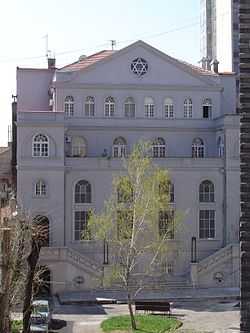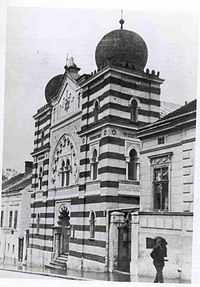Belgrade Synagogue
| Sukkat Shalom Synagogue Serbian: Београдска синагога | |
|---|---|

The synagogue today | |
| Basic information | |
| Location | Belgrade |
| Affiliation | Judaism |
| District | Obilicev Venac |
| Municipality | Stari Grad |
| Ecclesiastical or organizational status | active |
| Architectural description | |
| Architectural type | Neoclassical |
| Completed | 1925 |
Sukkat Shalom Synagogue or Belgrade Synagogue (Serbian: Београдска синагога / Beogradska sinagoga) is currently the only fully active Jewish place of worship in Belgrade, as other synagogues citywide are not active.
It is located in central Belgrade area - near Obilićev Venac Square and central high street Knez Mihailova.
On June 15, 1924 there was a solemn ceremony for the laying of the cornerstone, within which a charter containing texts in Hebrew and Serbian was sealed. The charter was signed by King Alexander and Queen Maria of Yugoslavia. The general construction was finished by November 1, 1925, and once the interior had been completed, the building was finally opened in the summer of 1926, and consecrated by Rabbi Šlang.
The synagogue was built on land bought from the city by the Society of Ashkenazi Jews of Belgrade. According to official plans the building was to house the synagogue, ritual baths, a school, community offices and apartments for the community employees. There had been an older Ashkenazi synagogue in the vicinity of the present one since the 19th century, but it was torn down to make way for new urban development. The synagogue is known in Belgrade as the "Kosmajska Temple", as its address before World War II was Kosmajska Street. The name of the street has since been changed to Maršala Birjuzova Street (Marshal Biryuzov Street).
Traditionally this synagogue had followed the Ashkenazi rite and served a congregation of Belgrade Jews who spoke Yiddish. Today, however, it serves the small, mostly Sephardic, Jewish community remaining in the city following the Holocaust. There are regular services on Friday evenings and Jewish holidays. The rabbi serving this synagogue is the head rabbi of Serbia, Isak Asiel.
Housed in the same building there is a community center for Jewish youth as well as rooms for occasional community functions and meetings. A Jewish kindergarten has recently been opened at the building as well. For many years now, the building has also housed several families affiliated in some way with the local Jewish community.
The architectural style is late Neoclassicist (usually classified as academic style in this part of Europe), with an enclosed yard to the front. The building is graced with a large central staircase which dominates its façade together with the four grand windows of the synagogue chambers, as seen in the picture. The gable façade has a prominent round window at its center bearing the Star of David.
The interior was partially renovated in 1990, and the city authorities have announced a general restoration program for the near future.
There is one other surviving synagogue building in the Belgrade area, located in the town of Zemun. Built in 1850, it is not in use today, although it is still recognizably a Jewish place of worship.
One of the most prominent alternative cultural centers in Belgrade and Serbia today, the so-called "Cinema Rex", is situated in a building formerly belonging to Belgrade's Jewish societies "Oneg Shabat" and "Gemilut Hasadim". The building, designed by architect Samuel Sumbul, is a rare example, possibly the only example, of Sephardic pseudo-Moorish architecture in the city. It is equipped with a small concert and performance hall and various exhibition and office spaces. The cultural centre Rex is located in Dorćol in Jevrejska Street (Jewish street). In earlier days this street was the nucleus of the Jewish community and throughout its history it has had the same name.
Jews in Belgrade
The first written records of the presence of Jews in Belgrade date back to the 16th century when the city was under Ottoman rule. At that time Belgrade boasted a strong Jewish Ladino-speaking Sephardic community mostly settled in the central Belgrade neighborhood called Dorćol. The city's Ashkenazi Jews, many of them from Central Europe and nearby Austria-Hungary, mostly lived near the Sava river in the area where the current active synagogue stands.

The Jewish community in Belgrade flourished most notably in the 17th century when Belgrade had a yeshiva (a Jewish religious school), numerous community and cultural centers, Jewish charitable organizations, societies and shops. A beautiful early-20th century Sephardic synagogue, then one of the most prominent buildings in the city, stood in today's Cara Uroša Street (see image right) complete with ritual bathing quarters.
Before World War II some 12,000 Jews lived in Belgrade, 80% of whom were Spanish- or Ladino-speaking Sephardim, and 20% Yiddish-speaking Ashkenazim. Only 1,115 of Belgrade's twelve thousand Jews would survive. Ninety-five per cent of the Jewish population of Serbia was exterminated during the German occupation. There were three concentration camps for Jews, Serbs and Gypsies in the city at the time. The majority of Jews were murdered in Serbia. The Belgrade concentration camp Banjica. Its Commandant was the infamous pre-war police officer Svetozar Vujkovic. At least 23,967 Jews, Serbs and Gypsies passed through the camp.
Most Jewish men perished at the Autokomanda site near the city center, apart from those killed at the Banjica camp; the camp at Sajmište was on Independent State of Croatia territory and it mostly saw the destruction of women and children. Wartime bombing destroyed most of the Jewish monuments as well as much of the city. According to some reports the current synagogue was used by the occupying forces as a brothel.[1] The building was re-consecrated after the war. Since 1944 there has only been a very small Jewish community in Serbia and Belgrade.
Belgrade currently has a very active Jewish community center housing the Federation of Jewish Communities of Serbia and the Jewish Historical Museum. The city also has several commemorative monuments to Jewish suffering in past wars, the newest of which was unveiled at Autokomanda, near the site of the mass killing of Jews during WWII.
There are Sephardic and Ashkenazi Jewish cemeteries in Belgrade, but only the Sephardic one is in regular use today.
See also
- Judaism
- Ashkenazim
- Sephardim
- Sofia Synagogue
- Novi Sad Synagogue
External links
| Wikimedia Commons has media related to Belgrade Synagogue. |
- Official city of Belgrade site about Belgrade Jews (Serbian only)
- Jewish community of Belgrade
- Jewish community of Zemun
- Jewish Historical Museum in Belgrade
- History of Jews in Serbia
- Cinema Rex Cultural Centre (Serbian and English)
- Belgrade Sephardic music band
Footnotes
Coordinates: 44°48′55″N 20°27′26″E / 44.8153°N 20.4572°E